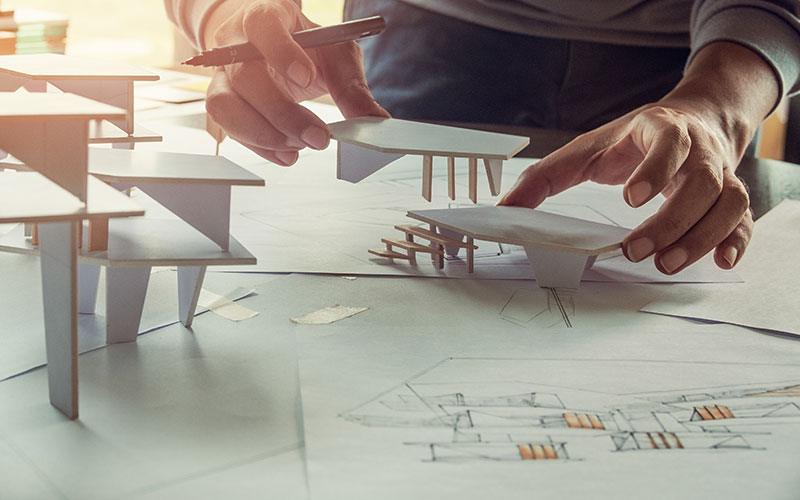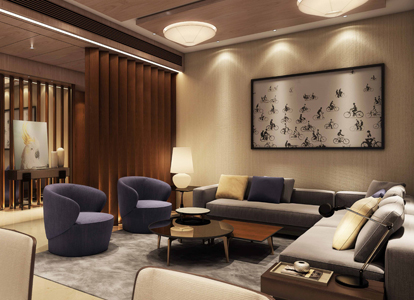
Behind the Scenes of an Interior Design Project
Behind every aesthetically designed space, there is inspiration and perspiration. Today, the interior designer’s job description is much more than conceptualizing a design — interior design service includes client handling, project management, contractor coordination, and much more. Every interior designer must walk a fine line between aesthetics and other elements to deliver incredible designs every time. A lot goes on behind the scenes from onboarding a client to the final project delivery.

Today, we will take you behind the scenes to understand the designer’s role in an interior design firm and how all departments come together to craft a winning interior design project.
1. Meeting the client
When a client approaches the interior design firm, the first step is to schedule a consultation or site meeting. At this preliminary stage, the interior designer needs to determine the clients vision for the new space, intended use of the area, style preference, and project timeline.
It is a thorough process that requires attention to detail. The client brief is the first step to creative conceptualization.
2. Discussing with the design team
The designer must determine client choices in the right direction. Equipped with all the information and insights provided by the client, the designer meets the design team to discuss the project. It involves:
– Space planning: The designer prepares an initial floor plan with the furniture. It will help to understand the flow and traffic throughout the space.
– Concept Creation: Based on client direction, the design team starts to prepare a few mood boards to present to the client.
3. Preparing a cost estimate with the pricing team
Based on the client’s requirements and design elements put together by the design team, the Estimation Team provides a cost estimate of the project to be undertaken.
4. Finalizing design concept and budget with the client
During this meeting, the designer and client discuss in-depth details on layout, colour palettes, furniture, fixtures, textures, lighting, etc. The designer also gives the client an offer letter with the estimated budget.
5. Preparing the final design layout with the design team
Based on the client’s requirements, site specifications, and the approved budget, the design team now prepares a room-by-room layout. It includes every fine detail, like which material/items to import or what to procure/manufacture locally, etc. The designer must also ensure the selected lights, wall finishes, flooring, and plumbing fixtures enhance the space. It is the first step to bringing design ideas to life.

6. Appointing a project management team
Most interior designers have a dedicated Project Management Team in charge of the project. The Project Management team liaises with the contractor/ sub-contractors, manages vendors, handles procurement and deliveries, conducts daily/weekly site visits, and provides quality control checks. The Project Management team is the thread that binds the creative side of the designer to the practical side of the site work.
7. Appointing and coordinating with the contractor
Once the design vision is clear, the interior designer has to appoint a contractor to handle the project site. The contractor is one point of contact between the design team and the site team. The contractor appoints painters, plumbers, masons, carpenters, electricians, and other labourers who work according to the specifications and drawings provided by the interior designer. As work progresses, the interior designer has to coordinate closely with the general building contractor/s to maintain the quality, perfection, and line levels of work.
8. Working with the procurement department
Once the options are decided, the procurement team contacts various vendors for samples. Be it a material swatch, a tile, hardware, or a light fixture, the procurement department’s job is to find it. This process can take from days to weeks, depending on the availability of the products. Sometimes, even after browsing through thousands of pieces from large suppliers like VersaLite, the designer may decide to get custom-made few pieces for the project.
9. Balancing clients, contractors, vendors, and other parties
An average interior design project takes between 10-12 months to complete. The interior design team needs to ensure that the design elements are proper and suit the ambiance of the particular design space. Also, if the client requests edits or changes, they must be conveyed by the designer to the contractor and site teams. Smooth coordination is necessary between all parties – designer, client, contractors, and vendors to ensure the project is completed on time and within the estimated costs.
10. Raising the invoice with the accounts department
The interior designer has to present a final bill to the client. The accounts department raises the final invoice. Before preparing the final bill, it will check the amount of the advance payment received and any other amounts collected in tranches.

Conclusion
Clients want a beautifully-designed space but lack the time or expertise. So, several top interior designers are now offering a one-stop full interior design service. Project management, customer service or liaising with other departments is complex and time-consuming. At every stage, it is about communication and coordination. But despite this and all the hard work behind the scenes, the top interior designers continue to deliver aesthetically designed spaces on time, every time!





